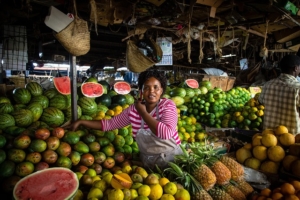The Positive Impacts of Mobile Banking in Kenya
 For the past 18 years, mobile banking in Kenya has helped thousands of people gain control over their money while reducing the country’s poverty rates. The phone-based mobile money service named M-PESA, started by Vodafone in cooperation with Safaricom, has expanded financial inclusivity by allowing access to financial services for even the unbanked through the convenience of a mobile phone. According to the Vodafone website, “M-PESA offers a safe, fast and low-cost way to pay, receive, transfer and store money.” Through local M-PESA agents, individuals are able to withdraw, send or deposit cash, negating the need to visit a bank that may be located far away from a community.
For the past 18 years, mobile banking in Kenya has helped thousands of people gain control over their money while reducing the country’s poverty rates. The phone-based mobile money service named M-PESA, started by Vodafone in cooperation with Safaricom, has expanded financial inclusivity by allowing access to financial services for even the unbanked through the convenience of a mobile phone. According to the Vodafone website, “M-PESA offers a safe, fast and low-cost way to pay, receive, transfer and store money.” Through local M-PESA agents, individuals are able to withdraw, send or deposit cash, negating the need to visit a bank that may be located far away from a community.
More than Mobile Banking
One of the main benefits of M-PESA is that a bank account is not necessary for using its services. This is a significant advantage to impoverished people in rural, remote areas who cannot afford hefty bank fees, do not earn enough to warrant the opening of a bank account, do not have the formal documentation necessary to open a bank account or simply reside too far away from a bank, making bank services costly and inconvenient.
M-PESA transaction fees are low and M-PESA resolves the need for individuals to travel long distances with physical cash to give to another, which could also be potentially dangerous. With many M-PESA agents, typically local small businesses or vendors, situated across Kenya, individuals can easily transact whenever necessary.
M-PESA was officially launched in Kenya in 2005, and by 2016, Kenya had 40,000 M-PESA agents operating in the country and more than 20 million M-PESA users in a country of 47 million people at the time. A study published in 2016 by Georgetown economics professor Billy Jack, and a colleague at MIT, Tavneet Suri, highlights the impacts of M-PESA on poverty in Kenya. The researchers conclude that between 2008 and 2014, MPESA “increased per capita consumption levels and lifted 194,000 households, or 2% of Kenyan households, out of poverty.”
Statistics from the World Bank confirm the poverty reduction progress during this period. The percentage of Kenyans living under the poverty line dropped from 46.8% to 36.1% over a period of one decade ranging from 2005 to 2015. Kenya’s rural areas noted the most significant decrease as poverty declined from around 50% in 2006 to about 38.8% in 2016, marking a decrease greater than 10%.
Empowering Women
The study by Jack and Suri states, “The impacts, which are more pronounced for female-headed households, appear to be driven by changes in financial behavior — in particular, increased financial resilience and saving — and labor market outcomes, such as occupational choice, especially for women, who moved out of agriculture and into business.”
In the report, Suri mentions that the service helped about 185,000 female farmers move out of farming jobs and into business or retail, giving them a more secure income considering the volatility of the agricultural industry due to changing weather patterns.
Other Issues Impacting Kenya
Despite mobile banking in Kenya bringing poverty rates down, Kenya is currently grappling with the impact of severe droughts, and this is affecting the financial and food security of farming families.
A press release by the International Rescue Committee in February 2023 highlights that the current drought in Kenya has the potential to leave 5.3 million Kenyans facing acute food insecurity from March to June 2023. The report notes that 2.4 million livestock have died due to recent droughts, putting pastoralist families out of work and diminishing their food security.
A United States Agency for International Development (USAID) press release in February 2023 reports that the Horn of Africa has experienced a fifth failed rainy season and Kenya’s cumulative rainfall is now 70% lower than the country’s 30-year average. On top of previous aid measures, USAID intervened in February 2023 with a provision of more than $126 million in emergency food aid to cover the needs of about 1.3 million Kenyans in drought-affected areas.
People will receive food aid in the form of physical food items or cash-based assistance, depending on whether or not local markets are operational. Cash-based assistance will not only allow families to purchase food items according to their needs and preferences but will also help boost local economies as local vendors will see an increase in sales.
Looking Ahead
In spite of the challenges posed by drought and food insecurity, mobile banking in Kenya, particularly through the M-PESA service, has made significant strides in reducing poverty rates and empowering marginalized communities. By providing easy access to financial services and enabling secure transactions, M-PESA has helped lift thousands of households out of poverty and fostered financial resilience, particularly among women. As Kenya continues to tackle the impact of droughts, ongoing support from organizations like USAID will help alleviate food insecurity and further boost local economies through cash-based assistance programs.
– Samuel Kalantzis
Photo: Pixabay
